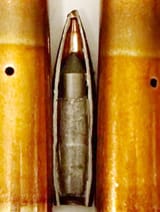Search Results
7/17/2025, 3:26:29 AM
>>63993573
I agree completely. I think you can break rounds into four camps.
1. The garden variety, composed of everything from pistol ammo to M855 / M193, then M855A1 to M80A1, M61, B-32, M2AP. Rounds that can pierce certain varieties of armor but comfortably all fall within the proxy envelope of NIJ RF3 / Level IV.
2. The brute-forcers. Rounds that brute force their way through armor by virtue of just being fuckheug. .50 BMG and 12.7x108 / 14.5x114. Even in non-AP versions these rounds can produce excessive behind-armor-blunt-trauma and beat plates that aren't up to par.
3. The less-garden variety. Entry level tungsten core AP. M993, Swiss P AP, 5.56 M995 and AP4. These can be handled by a higher rung of plates, like either XSAPI or Colossus or LTC 28601, etc.
4. The next-gen, composed of the real nasty threats like 7N37, M1158, XM1184, SmKH, 7N37M, 7N51 (pic rel), then the harder .338 APs like AP529, API526, M1154 (M1158's big bro), M1214 mini-Raufoss, and the rumored 7N45. M948 falls kinda half into this camp, half into camp #2, but the Swedish SLAP (PTR 10 PRICK) is firmly camp #4.
You can have plates in camp #2 that lose to camp #3-4 threats. You can have plates in camps #3-4 that lose to camp #2 because of how the relationship between strike face and backer works with modern ceramics. The old Ceradyne .50 cal plates can handle .50 BMG M33 at a certain velocity, probably a lot better than a FORT ACP-M can, but I wouldn't trust those boron carbide / fiberglass Ceradynes to not amorphize against 7N37 and other WC-core penetrators. You need a stronger strike face to handle tougher cores, but you need more backer to control resulting fragments and minimize BFD / resulting BABT.
I agree completely. I think you can break rounds into four camps.
1. The garden variety, composed of everything from pistol ammo to M855 / M193, then M855A1 to M80A1, M61, B-32, M2AP. Rounds that can pierce certain varieties of armor but comfortably all fall within the proxy envelope of NIJ RF3 / Level IV.
2. The brute-forcers. Rounds that brute force their way through armor by virtue of just being fuckheug. .50 BMG and 12.7x108 / 14.5x114. Even in non-AP versions these rounds can produce excessive behind-armor-blunt-trauma and beat plates that aren't up to par.
3. The less-garden variety. Entry level tungsten core AP. M993, Swiss P AP, 5.56 M995 and AP4. These can be handled by a higher rung of plates, like either XSAPI or Colossus or LTC 28601, etc.
4. The next-gen, composed of the real nasty threats like 7N37, M1158, XM1184, SmKH, 7N37M, 7N51 (pic rel), then the harder .338 APs like AP529, API526, M1154 (M1158's big bro), M1214 mini-Raufoss, and the rumored 7N45. M948 falls kinda half into this camp, half into camp #2, but the Swedish SLAP (PTR 10 PRICK) is firmly camp #4.
You can have plates in camp #2 that lose to camp #3-4 threats. You can have plates in camps #3-4 that lose to camp #2 because of how the relationship between strike face and backer works with modern ceramics. The old Ceradyne .50 cal plates can handle .50 BMG M33 at a certain velocity, probably a lot better than a FORT ACP-M can, but I wouldn't trust those boron carbide / fiberglass Ceradynes to not amorphize against 7N37 and other WC-core penetrators. You need a stronger strike face to handle tougher cores, but you need more backer to control resulting fragments and minimize BFD / resulting BABT.
Page 1
